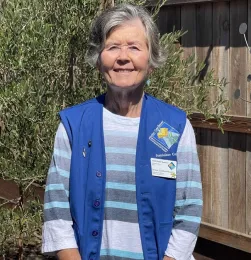
Pollinators that hang around our gardens include bees, butterflies, hummingbirds, beetles, and flies. While all these pollinators are important, bees make up about 50% of pollinators.
Native Bees Prominent Role
When you see bees in your garden, you likely see many European honeybees (Apis mellifera), who are crucially important to the Central Valley's agriculture since Honeybees pollinate 90% of the almond crop. But Honeybees are not the only bees in search of nectar in farmers' fields and our gardens. There over 4,000 species of native bees in the United States, with about 1,600 in California.
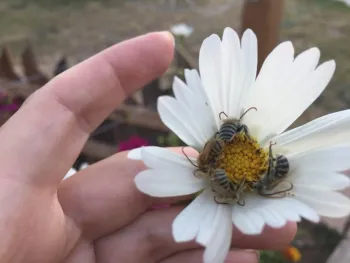
Native bees play an important role in pollinating our plants since they are 200 times more efficient at pollination than Honeybees. Studies in the Central Valley have shown three dozen or so native bee species provide sufficient pollination services for a single farm. For example, pollinating an acre of apples requires 60,000-120,000 Honeybees; the same area can be pollinated by 250-750 Mason bees (Megachile).
Social Characteristics and Nesting Habits
Most bees are solitary in nature, generally producing honey only for their own consumption and/or for their young. Nesting habits vary from social hives/colonies to solitary nesting in the ground or woody material.
- Social vs. Solitary bees:
o Solitary bees make up 99% of all bees in North America, with social bees making up less than 1%. Only Honeybees and Bumblebees are social, living in colonies, with all other bees being solitary. Most Honeybees are domesticated, living in hives. Bumblebees live in the wild, in colonies which are generally underground. Honeybee hives will have a population of 10,000-50,000 bees, while Bumblebees will have only 50-400 in their colonies.
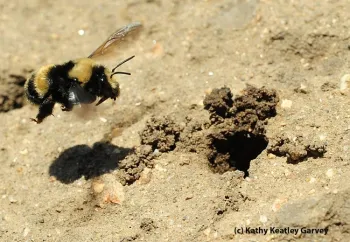
- Ground nesting bees make up 70% of bees:
o Mining bees and Digger bees (Adrena): As their names indicate, these bees have a ground-nesting lifestyle. From the outside, the tunnels look like holes with a ring of loose soil around them and can be mistaken for small ant hills or earthworm mounds. Mining bees are active only in the spring for 4-8 weeks during which the females dig tunnels to lay their eggs and raise their young. Both bees are extremely docile, rarely stinging.
- Stem and wood nesting bees make up 30% of bees:
o Leafcutter bees (Megachilidae) use a “wrapper” of leaves, resin, and sand to build their nests in natural or artificial cavities. If you see some leaves in your garden with their distinctive circular “cut out,” you will know you have some in your area. They are about the same size as honeybees, but their bodies are black and furry while Honeybees are dark brown to black and yellow striped.
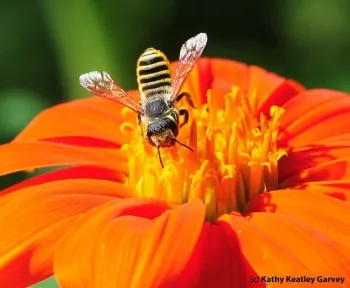
o Mason beesconstruct their nests from mud, preferring hollow stems or holes made by wood-boring insects. Some people hang bee “houses” with hollow tubes to attract these bees to nest in their yard.
Generalist vs. Specialist Bees
Some bees are generalists, getting their nectar from a wide variety of flowers. These include the Bumblebee and the Mason bee.
Other bees are specialists, feeding only from very specific flowers, such as the Squash bee (two genera: Peponapis and Xenoglossa) or the Sunflower bee (Megachile) with their common names indicating which type of flowers they favor.
Other Native Bees
Other bees you may see in your garden:
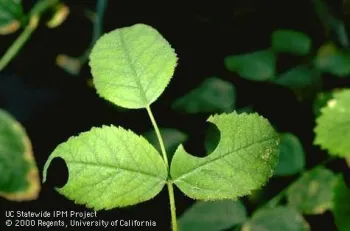
- Carpenter bees (Apidae): Females are shiny black and can sting, but only if provoked. Males are golden and can't sting. Their name derives from their nesting behavior; nearly all species burrow into hard plant material such as dead wood or bamboo. Occasionally they may nest in unpainted wood siding of buildings.
- Sweat bees (Halictidae): Sweat bees' common name is due to their tendency to land on and lick the sweat from people's skin! One of the coolest looking bees in this group is the green sweat bee, which has a shiny, iridescent exoskeleton. Most of these bees nest in the ground, though some nest in wood. Some species are cleptoparasites, meaning they will lay their eggs on food in another species' nest and after hatching, the larva kills the host's larva!
- Long-horned bees (Melissodes): With medium to large bodies, this non-aggressive group gets their names from the long antennae of the males, which females lack. Females have a solitary nest in the ground whereas males sleep outside, often spending the night in groups on the surface of a flower.
Bees are in Trouble
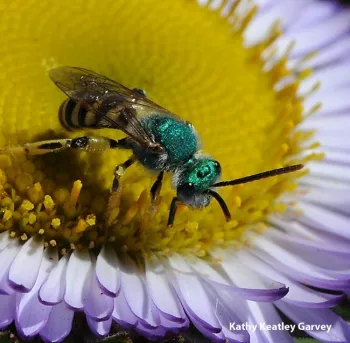
Some ways you can help:
- Plant a garden full of flowering plants to attract bees and other pollinators. Make sure you have something blooming during each of the spring, summer, and fall seasons. Whenever possible, plant native plants since native bees and plants evolved together.
- If you use a pesticide, choose one that is less toxic such as a horticultural soap or oil and spray in early morning or evening when pollinators are unlikely to be present. (https://ipm.ucanr.edu/GENERAL/pesticides_urban.html)
- Provide spaces for nesting bees, with bee houses and bare patches of soil, along with a source of water.
By providing a bee-friendly garden, you can help the vital native bee pollinators thrive.
Denise Godbout-Avant has been a UCCE Master Gardener with Stanislaus County since 2020

